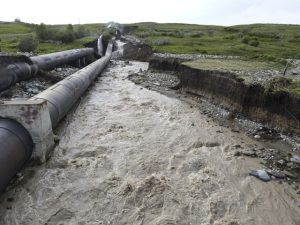Catastrophic flooding in Montana gifts water to Alberta
By Justin Sibbet, Local Journalism Initiative Reporter
A crack, a bang and a burst. Thousands of litres of water flowed freely from a pipe in the U.S. to the Alberta side of the international border.
Following the major break at the St. Mary River Siphon near Babb, Montana, on Monday, water that would normally have been diverted to the American portion of the Milk River is now making its way into the St. Mary’s Reservoir in Alberta.
David Westwood, general manager for St. Mary’s Irrigation District, says this presents an opportunity for the reservoir to fill far beyond where estimates showed it would be able to this year.
“I think we could get closer to actually getting it filled this year, which I don’t think it was on that trajectory, but this might put it over the top. It really depends on how long this siphon takes to repair.”
Unfortunately, the flooding caused severe damage to a bar, hotel and roping arena in Montana. However, the Milk River Project says it could have been a lot worse.
“No one was hurt, but the damage is extensive,” said the organization in a post on Facebook.
Even with the challenges in Montana, the positives for silver lining for Alberta cannot be overstated, says Westwood.
“We get the benefit of all the water coming,” said Westwood.
This comes during a year in which drought conditions have left many on edge, with the Calgary watermain break causing even greater concerns across Alberta.
However, this burst is not the first time in recent years the Milk River has created challenges in Montana.
“This is similar to the event, not (in terms of scale), but same kind of cause and effect that happened back in 2020 when they had a drop structure failure.”
He says the repairs in 2020 took months, but this time around should be much faster.
“I think the siphon is going to be a quicker repair, but a similar result in that they have to stop water from being diverted down that path,” said Westwood.
He says it will take some time to fully understand the impact this will have on southern Alberta, but initial signs show it will at least help in the immediate future.
The Lethbridge Herald reached out to the U.S. Bureau of Reclamation for comment on the situation but no response was received by deadline.

